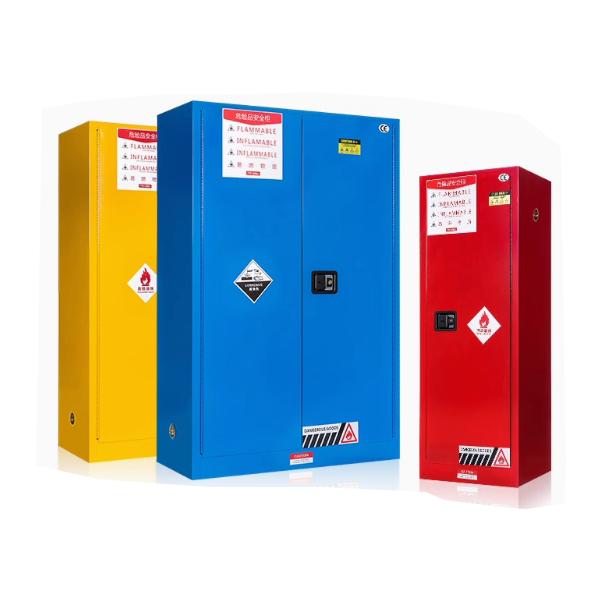Table of Contents
When running a laboratory, safety is always a top priority. Proper storage solutions are critical for ensuring that hazardous materials, chemicals, and sensitive equipment are handled and stored safely. Choosing the right storage cabinets not only protects your lab personnel but also helps your lab remain compliant with industry regulations and standards. Whether you’re setting up a new lab or upgrading your storage, this guide will help you understand the essential safety considerations when selecting laboratory storage solutions.
Why Proper Laboratory Storage Matters
Laboratories house a wide range of chemicals, flammable materials, biological samples, and delicate instruments. Improper storage can lead to spills, contamination, fires, and exposure to harmful substances, putting the health and safety of lab personnel at risk. Moreover, inadequate storage solutions can result in non-compliance with safety regulations, leading to fines, shutdowns, or legal issues. That’s why investing in the right lab storage cabinets is crucial.
Key Considerations for Choosing Safe Laboratory Storage Solutions
Assess the Types of Materials You’ll Be Storing
Before selecting a storage cabinet, it’s essential to know what you’ll be storing. Different materials require different safety measures. For instance, flammable chemicals should be stored in flame-resistant cabinets, while corrosive chemicals need cabinets made from corrosion-resistant materials. For hazardous biological samples, consider cabinets designed to prevent contamination.
Types of Materials and Corresponding Storage Cabinets:
Flammable Chemicals: Fire-resistant, explosion-proof cabinets.
Corrosive Chemicals: Cabinets lined with corrosion-resistant materials like polyethylene or phenolic resin.
Hazardous Biological Materials: Refrigerated or ventilated storage cabinets with lockable features.
Sensitive Equipment: Temperature-controlled or dust-proof cabinets.
Comply with Safety Regulations and Industry Standards
One of the most important factors when selecting lab storage is ensuring compliance with safety standards set by OSHA (Occupational Safety and Health Administration), NFPA (National Fire Protection Association), and EPA (Environmental Protection Agency). The storage of chemicals and hazardous materials must meet specific guidelines to prevent accidents and ensure a safe working environment.
Key Compliance Requirements:
OSHA requires that hazardous chemicals be stored in approved containers and cabinets.
NFPA 30 outlines requirements for flammable liquid storage, including ventilation and fire protection systems.
EPA regulations govern the safe storage of hazardous waste materials, ensuring they’re handled in environmentally responsible ways.
Consider Ventilation and Temperature Control
For certain chemicals and materials, proper ventilation is critical. Some chemicals release vapors that can build up and create toxic or flammable environments, so ventilated storage cabinets are essential. Additionally, temperature control is crucial for storing materials that can become unstable at extreme temperatures. Cabinets with built-in ventilation systems or climate control help prevent these risks.
Examples of Materials Requiring Ventilation and Temperature Control:
Volatile Organic Compounds (VOCs): Require ventilated storage to prevent vapor buildup.
Temperature-Sensitive Chemicals: Need refrigerated or climate-controlled cabinets.
Biological Samples: Often require precise temperature settings to maintain integrity.
Evaluate Durability and Construction Materials
Lab storage cabinets must be durable enough to withstand daily use and exposure to potentially corrosive chemicals. Stainless steel, polypropylene, and epoxy-coated steel are popular choices for lab furniture due to their resistance to chemicals and wear. For highly corrosive environments, cabinets made from polyethylene or phenolic resin offer maximum protection.
Durable Construction Features to Look For:
Fire-Resistant Materials: For flammable storage cabinets
Corrosion-Resistant Coatings: For chemical storage cabinets.
Seamless Interiors: To prevent chemical spills from seeping into hard-to-clean areas.
Heavy-Duty Locks: For securing hazardous materials.
Prioritize Security and Accessibility
Labs often contain valuable equipment and hazardous substances that need to be stored securely. Cabinets should have locking mechanisms that prevent unauthorized access while still allowing quick access in emergencies. Consider cabinets with keyless entry, RFID locks, or combination locks for enhanced security.
In addition to security, think about accessibility. Well-designed cabinets should allow for easy organization and quick retrieval of stored items. Adjustable shelves, transparent doors, and labeled storage spaces help improve efficiency without compromising safety.
Plan for Future Expansion and Versatility
As your lab grows, so too will the need for additional storage space. Investing in modular storage solutions that can be expanded or reconfigured as needed is a smart, long-term investment. Look for cabinets with adjustable shelving, stackable units, or modular designs that can easily be integrated into your lab’s future setup.
Modular Storage Benefits:
Flexibility: Easily adapt to changing storage needs.
Scalability: Expandable storage without the need for a complete redesign.
Customizable: Tailored to fit specific lab requirements.
Think About Emergency Preparedness
In case of a chemical spill or emergency, having proper storage solutions in place can prevent accidents from escalating. Cabinets should be clearly labeled with hazard symbols, and emergency eyewash stations and spill kits should be readily accessible near chemical storage areas. Additionally, cabinets for flammable or hazardous materials should be equipped with two person key and internal containment systems to manage spills.
Common Storage Solutions for Different Lab Environments
To ensure the safety of your lab, you’ll want to match storage cabinets to the specific demands of your environment:
Chemical Laboratories: Invest in corrosion-resistant, ventilated storage cabinets to prevent dangerous fume buildup.
Biological Laboratories: Choose secure, temperature-controlled storage units for biological samples and sensitive instruments.
Pharmaceutical Laboratories: Opt for modular storage with precise climate controls for pharmaceuticals and chemicals.
Conclusion
Choosing the right laboratory storage solutions is critical for maintaining safety, ensuring compliance with regulations, and protecting both personnel and materials. Whether your lab handles flammable liquids, corrosive chemicals, or sensitive biological samples, selecting the proper storage cabinets can prevent accidents and keep your lab running smoothly. When planning your storage solutions, always consider material type, durability, regulatory compliance, and future adaptability to ensure the best fit for your lab’s unique needs.
By following these guidelines and investing in quality lab storage, you not only safeguard your lab but also create an efficient, compliant, and future-ready workspace.




